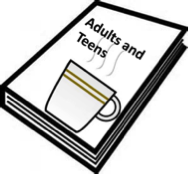Note: These criteria emphasize materials at the lowest reading levels. Some adults with Cognitive Challenges can read at higher levels
Appeal:
The book as a whole has potential appeal to adults
Content and Typography:
The content could interest adults. If children appear in the story, the focus is not on them
The print is fairly large, with plenty of space between words and lines
There are only a few words on each page with good contrast between the print and the background
The type font uses the most familiar shapes of letters, and there are few, if any serif fonts. Whenever possible, Sans Serif fonts should be sought and utilized, as they increase usability and accessibility for all users, including those without disabilities

Photographs, Pictures, and Other Illustrations:
If people are pictured, only adults or both children and adults are represented Ideally, the pictures include people of all ages, both sexes, and a mix of cultural groups Illustrations are realistic, bright, colorful, and clear
Photographs are colorful with high-quality reproduction and good contrast with minimal glare
Special Consideration:
Some books written at a higher reading level may be suitable if the content is sufficiently interesting to attract beginning readers and challenge them to learn new vocabulary and concepts
Wordless picture books often have excellent potential if the pictures are not too babyish
Datedness:
Unless the story’s setting is historical, hairstyles, fashions, and cars pictured should be contemporary Books on looking for jobs and managing money should be recent enough to present realistic examples
Subtle Messages:
Some books give subtle clues that they are intended for children (e. g., in one book the text reads, “It helps you grow. It makes you strong.”
The covers of some books carry series titles like “Junior World Biographies,” spines may be labeled “Chelsea Juniors,” dust cover notes may refer to children
Some otherwise appropriate books include “notes to Parents” or “Notes to Teachers”
Usually, “Juvenile Literature” appears in the subject heading provided with the Cataloging-in Publication (CIP) information
*For more detail, see Walling, L. L., & Cruce, M.M. (1995). Recreational Reading for Adults with Mental Retardation. In Walling, L.L., & Irwin, M. M. (Eds.), Information services for people with developmental disabilities: The library Manger’s handbook (pp.197-209). Westport, CT: Greenwood Press